The Voyage of Hasekura Tsunenaga (1613-1620) was
remarkable in its scope and vision standing in hard contrast to
the policies of the Tokugawa in their attempts to control the political
climate, foreign trade and impact of the outside world on Japan
in the early 17th Century. This journey wrote a remarkable chapter
in Japanese History.This voyage of a delegation of 180 men was begun
in 1613 at the time Jamestown the first
English Colony in America was just seven years old and struggling
to establish a foothold in Virginia. Hasekura's mission traveled
from Japan to Europe crossing both the Pacific and Atlanitc and
returned again to Japan arriving back in Japan in 1620, the same
year that Plymouth Colony was established
by a group of 140 Pilgrims coming to America from England by the
way of Holland.
This journey was the highwater mark of the use
of ships for the Japanese in the 17th century.
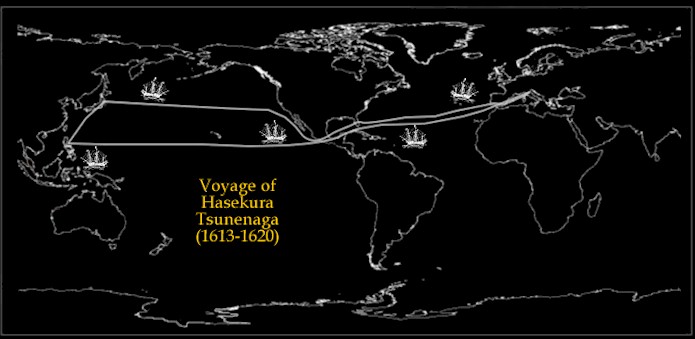
The Voyage of Hasekura Tsunenaga and his emissaries to Rome
crossed two oceans and Mexico between Alcopulco and Veracruz
becoming the first transoceanic voyage made in a galleon
built entirely by Japanese Shipwrights
Hasekura Tsunenaga was a retainer of Date Masamune
the founder and Daiymo of Sendai Japan. He led a political delegation
to Mexico and Europe (1613 - 20) and was the first Japanese political
envoy to visit the American continent. In the early 17th century
Japanese merchants were making efforts to trade with the west
on their own. In July of 1611 an emissary under Sebastion Viscaino
brought back from Mexico a group of Japanese merchants who had
traveled there with Rodrigo Vivero Y Velasco to establish trading
relations with Mexico in the previous year. This effort to establish
trading ties with Mexico inspired Date Masamune to send his own
delegation to seek trade with Mexico and Southern Europe. Date
Masamune appointed Hasekura Tsunenaga, a veteran of Toyotomi Hideyoshi's
invasions of Korea 1n 1592 and 1597, as his personal representative
to lead this delegation.
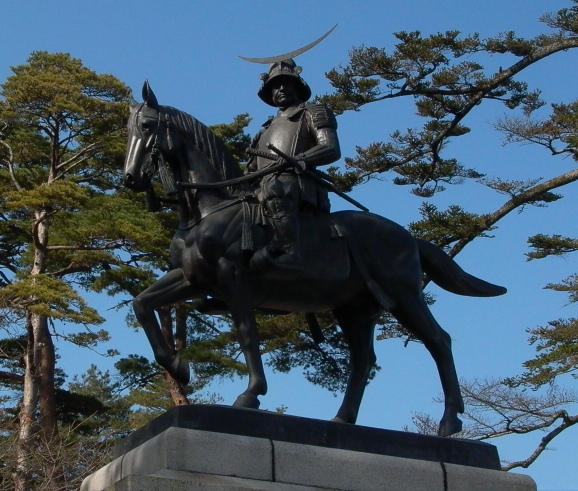
Date Masamune the founder and Diaymo of Sendai Japan (Born 1567
- Died 1636)
At the onset of Hasekura's mission it seems obvious
that Date Masamune was functioning with a different set of goals
and aspirations from those of the Tokugawa. Date was prepared
to embrace Christian missionaries and trade with the west where
the Tokugawa was motivated by gaining control of the foreign trade
to the exclusion of foreign interests in Japan. In addition Date
undertook the building of seaworthy ships that could handle the
transoceanic voyages, an undertaking that Tokugawa Ieyasu had
attempted with limited success with the English mariner William
Adams. For this purpose, approximately 4,400 workers led by Vizcaino
from New Hispania and ship-building carpenters delegated from
the Tokugawa government built a 500-ton class galleon in just
six months. This was the largest of ships of this kind built by
the Japanese. The largest ship built under the supervison of William
Adams, had been 120 tons.
In October 1613 Hasekura, with a delegation of
180 Japanese, set out for Acapulco in the galleon built by Japanese
shipwrights under Spanish supervision. The ship was named the
San Juan Bautista (Saint John the Baptist). Its very name indicates
the interest Date Masamune had in Christianity at the time. Masamune's
interest in Christianity is further indicated by the letter which
he sent with his envoys to the Pope, one line which said "I’ll
offer my land for a base of your missionary work. Send us as many
padres as possible."
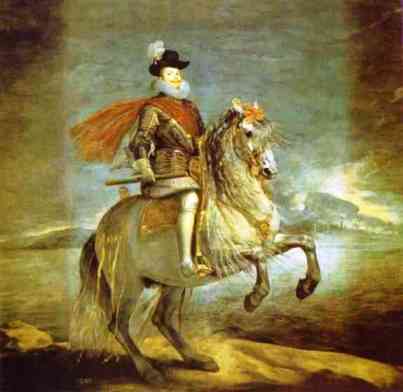
Philip III of Spain reign (1598-1621) by Diego Velázquez
Having just crossed the Pacific Ocean Hasekura
Tsunenaga had an audience with the Mexican viceroy in 1614. After
traversing Mexico between Acapulco and Vera cruz and the Atlantic
Ocean in 1615 he sailed for Spain where he met with the Spanish
monarch Philip III (1598-1621). While in Spain he was baptized
a Christian. The ceremony was conducted by the Archbishop of Toledo
and the Duke of Lerma was desginated as Hasekura's Godfather.
Hasekura'a delegation stayed in Spain for eight months before
traveling on to Italy.
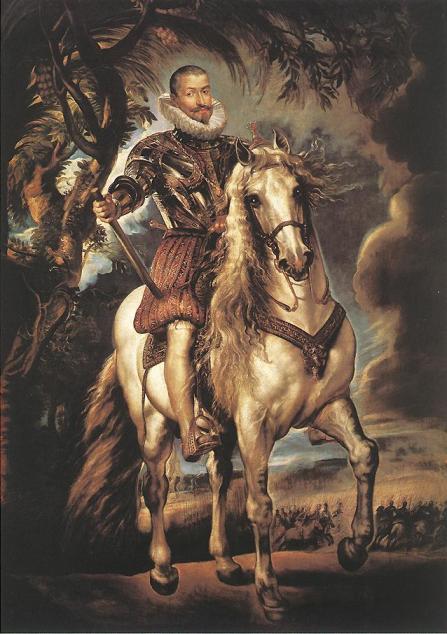
Hasekura Tsunenaga's Christian Godfather the Durk of Lerma
Painting By Peter Paul Rubens Circa 1603
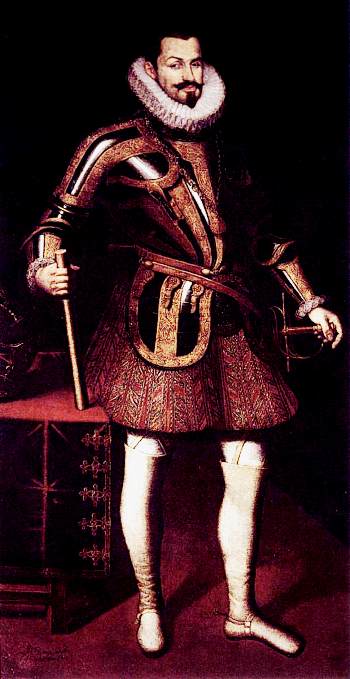
The duke of Lerma By Titian
The Duke of Lerma was the main administrator
of Phillip III's rule and in effect was the de facto ruler of
Spain, being designated as Haskekura's Catholic Godfather demonstrates
the importance the Spanish leadership put on the visit of Date's
delegation. Had Ieyasu's policies toward the Catholic influence
in Japan been different the ground work for the future would have
been firmly in Masumune's court, however the doors were being
shut to further missionary influences in Japan even as Hasekura's
delegation were being shown the courts of Spain and Italy.
In Rome he had an audience with
Pope Paul V (1605-1621) where Hasekura and his delegates were
well received, to the extent that Pope Paul V even granted Hasekura
Roman citizenship.
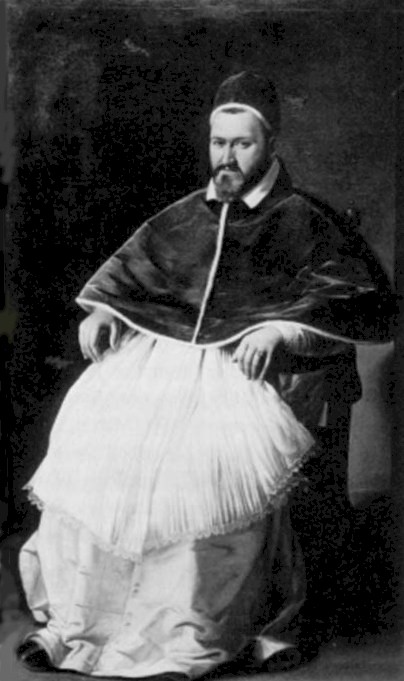
Pope Paul V (1605-1621) By Caravaggio
Hasekura arrived in Rome in 1615
the same year Galileo Galilei first went before the Roman Inquisition
to present his findings against geocentricism and it was the same
Pope Paul V who granted Hasekura his Roman Citizenship who repressed
the teachings of Copernicus and Galileo Galilei in the following
year labeling them as heretical.
During the course of Hasekura's mission, back
in Japan in February of 1614, Tokugawa Hidetada had issued another
edict expelling Christian priests from Japan and this resulted
in a hardening of the Spanish attitude toward trade with Japan.
Hasekura had met his objectives and accomplished his mission however
because of the repression of Christian Missionaries was becoming
the political agenda of the Tokogawa, Hasekura failed to secure
open trade agreements with the west for Date Masamune. Thirty
of Hasekura's delegates remained in Spain knowing that by returning
to Japan they would be persecuted as Christians.
The Japanese mission was the topic of much discussion
within the Jesuits circle in Rome and the motives for sending
this mission to Rome was hotly debated in view of what the church
understood the current policies of the Tokugawa to be. The politcal
climate in Japan and the recent restrictions made by the Tokugawa
against Christian missionaries was well known and success of the
mission was compromised by the differences between the statements
made by Date Masumune and the hard line taken by the Tokugawa
against foreign missionaries. It was clear that although Masumune
had sent his trade delegation to Rome that back in Japan Date
ruled at the discretion and favor of the Tokugawa and that it
was the policies of the Tokugawa that the Church had to be most
concerned with.
Hasekura Tsunenaga and his remaining delegates
made the return trip home to Japan making a stop over in the Philippines.
The delegation remained in the Philippines, another important
Japanese trading colony, and after two years in the Philippines
Hasekura returned to Japan in September 1620. Despite the fact
that this mission had been received favorably, and there was great
European interest in Japan, Date Masamune was forced to abandoned
his efforts at diplomacy and trade with the west after the political
agenda of the Tokugawa Shogunate banned Christianity in Japan
and began to severely limit and control Japan's contact with the
rest of the world. Date Masamune's focus would shift from foreign
diplomacy to saving his own political career in Japan where he
would have to again prove his loyalty to the Tokogawa despite
the evidence of his pro western leanings.
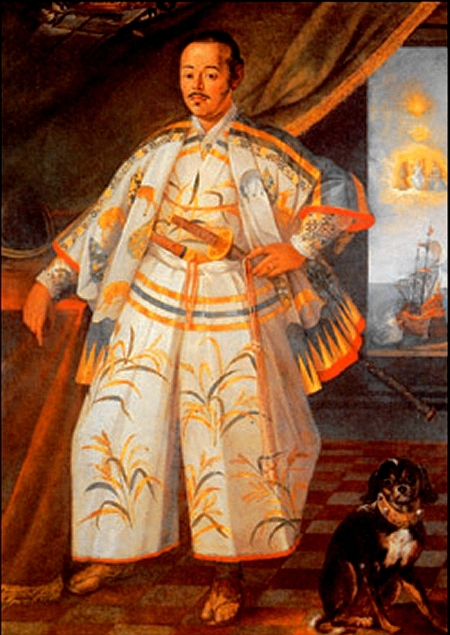
Hasekura's portrait done during his mission
in Rome in 1615 by Claude Deruet
The differences between the outlooks of the
two leaders can noted in the letters of Tokugawa Ieyasu and Date
Masamune. In Ieyasu's letter to Pope Paul V he stated "I
don't mind if you take advantage of coming to Japan to make a
profit but don't spread Christianity." On the other hand,
Date's letter said "I'll offer my land for a base of your
missionary work. Send us as many padres as possible."

Ship Detail from Hasekura Painting
Because of their different outlooks on trade
with the west and the desirability of having Christian missionaries
in Japan Date Masamune would come under suspicion of plotting
to overthrow the Tokugawa and the political climate in Date's
provinces would require him to prove again his loyalty to the
Tokugawa. The Tokugawa judged to a large degree the extent of
this loyalty on how Date dealt with the known Christian subjects
within his domain.
After Ieaysu's death the task would fall to Date
Masumune to finance the building his mortuary temple. This undertaking
would drain his financial coffers and allow the Shogunate to keep
his political allegiance to the Tokugawa under constant scrutiny.
After Hasekura's return Christain activities in Japan would be
severly curtailed by the Tokugawa.
To learn more of this epic adventure read Shusaku
Endo's historical novel "Samurai".
Hasekura Tsunenaga's , mission would be the one
and only journey of its kind using ships in the 17th century in
Japanese History.
